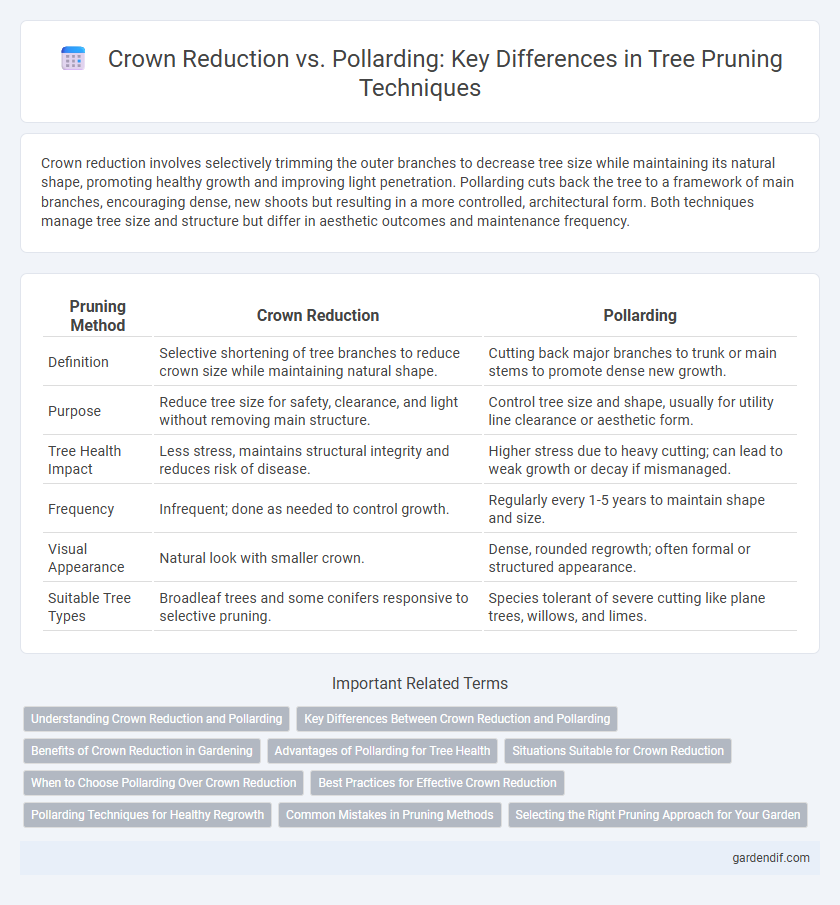
Crown reduction vs pollarding Illustration
Crown reduction involves selectively trimming the outer branches to decrease tree size while maintaining its natural shape, promoting healthy growth and improving light penetration. Pollarding cuts back the tree to a framework of main branches, encouraging dense, new shoots but resulting in a more controlled, architectural form. Both techniques manage tree size and structure but differ in aesthetic outcomes and maintenance frequency.
Table of Comparison
| Pruning Method | Crown Reduction | Pollarding |
|---|---|---|
| Definition | Selective shortening of tree branches to reduce crown size while maintaining natural shape. | Cutting back major branches to trunk or main stems to promote dense new growth. |
| Purpose | Reduce tree size for safety, clearance, and light without removing main structure. | Control tree size and shape, usually for utility line clearance or aesthetic form. |
| Tree Health Impact | Less stress, maintains structural integrity and reduces risk of disease. | Higher stress due to heavy cutting; can lead to weak growth or decay if mismanaged. |
| Frequency | Infrequent; done as needed to control growth. | Regularly every 1-5 years to maintain shape and size. |
| Visual Appearance | Natural look with smaller crown. | Dense, rounded regrowth; often formal or structured appearance. |
| Suitable Tree Types | Broadleaf trees and some conifers responsive to selective pruning. | Species tolerant of severe cutting like plane trees, willows, and limes. |
Understanding Crown Reduction and Pollarding
Crown reduction involves selectively shortening branches to decrease tree height and spread while maintaining natural shape, reducing weight and wind resistance. Pollarding is a drastic pruning technique cutting back all branches to a predetermined point, promoting vigorous regrowth and ensuring a uniform crown size. Both methods manage tree size and health but differ in intensity and regrowth patterns.
Key Differences Between Crown Reduction and Pollarding
Crown reduction involves selectively cutting back branches to reduce tree size while maintaining its natural shape and health, whereas pollarding is the removal of the entire tree canopy to encourage dense new growth from the top. Crown reduction preserves structural integrity and is typically less stressful for mature trees, while pollarding is commonly used for younger or specific species that tolerate severe cutting. These differences impact tree appearance, growth patterns, and long-term maintenance requirements.
Benefits of Crown Reduction in Gardening
Crown reduction enhances tree health by selectively removing upper branches, reducing wind resistance and minimizing storm damage risks. It preserves the natural shape of the tree while promoting new growth and improving light penetration to the garden below. This technique supports long-term structural integrity and increases safety around garden spaces compared to the more severe pollarding method.
Advantages of Pollarding for Tree Health
Pollarding promotes tree health by encouraging robust new growth while maintaining a manageable size, reducing wind resistance and the risk of limb breakage. This technique helps prevent decay and disease by removing older, weakened branches regularly, allowing the tree to allocate resources effectively. Pollarding also minimizes damage to surrounding structures and utilities, making it a sustainable choice for urban environments.
Situations Suitable for Crown Reduction
Crown reduction is suitable for situations where maintaining tree height and retaining the natural shape are essential, such as in urban landscapes or near power lines. This technique helps reduce the weight of heavy branches to prevent structural damage while preserving canopy density for aesthetic and ecological benefits. Crown reduction is preferred when gradual size control is needed without the severe regrowth typically associated with pollarding.
When to Choose Pollarding Over Crown Reduction
Pollarding is ideal for trees that require consistent size control while promoting dense new growth, especially in urban settings where space and clearance from power lines are critical. Choosing pollarding over crown reduction benefits species tolerant to hard pruning, such as willows and planes, ensuring long-term tree health and structural integrity. Pollarding is particularly effective during dormancy periods to minimize stress and optimize recovery for robust regrowth.
Best Practices for Effective Crown Reduction
Effective crown reduction requires precise cutting to maintain tree health and structural integrity while reducing canopy size. Best practices emphasize selecting appropriate branch points beyond the branch collar to promote rapid wound closure and minimize decay. Regular assessment of tree species' growth patterns ensures pruning cuts align with natural architecture, preventing stress and encouraging vigorous regrowth.
Pollarding Techniques for Healthy Regrowth
Pollarding techniques involve cutting tree branches back to a framework of primary limbs, promoting vigorous, controlled regrowth while maintaining the tree's structural integrity. This method encourages dense foliage and reduces the risk of weak, overextended branches typical in crown reduction. Regular pollarding cycles support healthy tree development by minimizing disease entry points and fostering a balanced canopy structure.
Common Mistakes in Pruning Methods
Crown reduction often results in excessive branch cutting, which can lead to weak regrowth and increased vulnerability to disease, while pollarding, when done incorrectly, may cause severe stress by removing too much foliage at once. Common mistakes include pruning beyond the branch collar and failing to maintain consistent intervals between pollard cuts, leading to decay and structural weaknesses. Proper technique requires understanding species-specific responses and timing to avoid long-term damage and promote healthy tree architecture.
Selecting the Right Pruning Approach for Your Garden
Crown reduction and pollarding are two pruning techniques that serve distinct purposes and suit different tree types; crown reduction involves selectively cutting back branches to reduce tree size while maintaining natural shape, ideal for minimizing storm damage or utility line interference. Pollarding, which cuts back all branches to a predetermined height, promotes dense new growth and is often used for formal or street trees requiring controlled size and shape. Assessing tree species, growth habit, desired aesthetic, and long-term maintenance requirements helps determine the most appropriate pruning method for your garden.
Crown reduction vs pollarding Infographic

 gardendif.com
gardendif.com